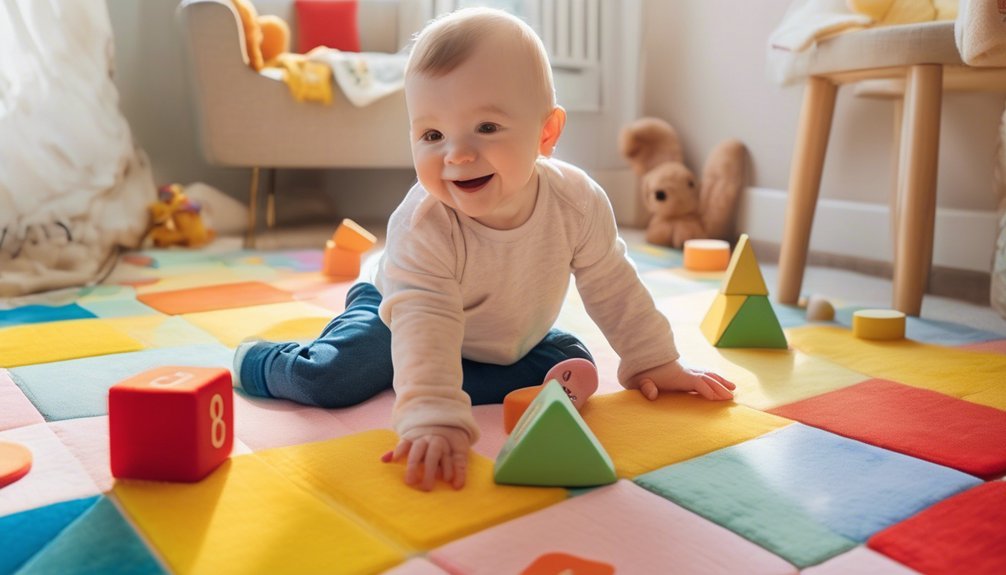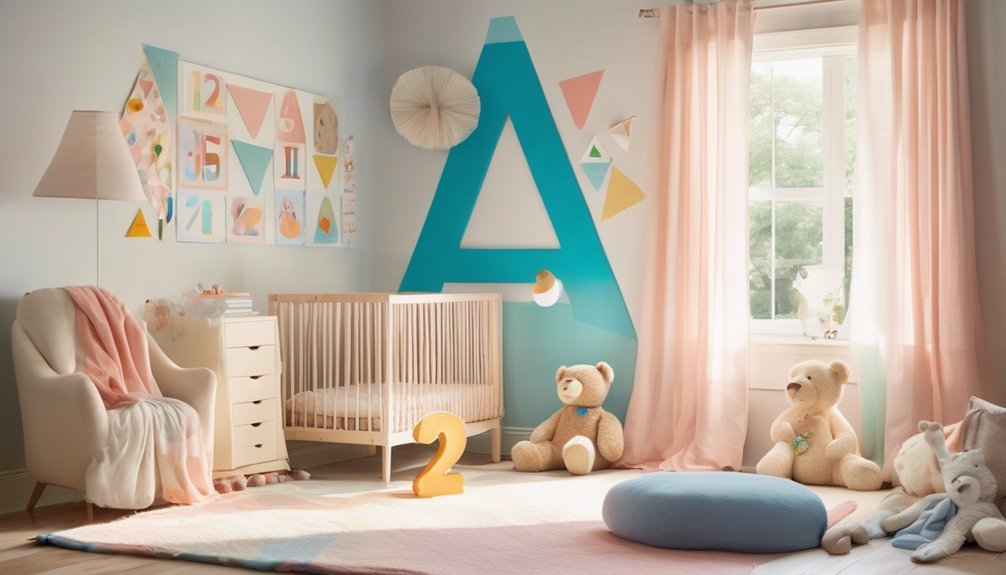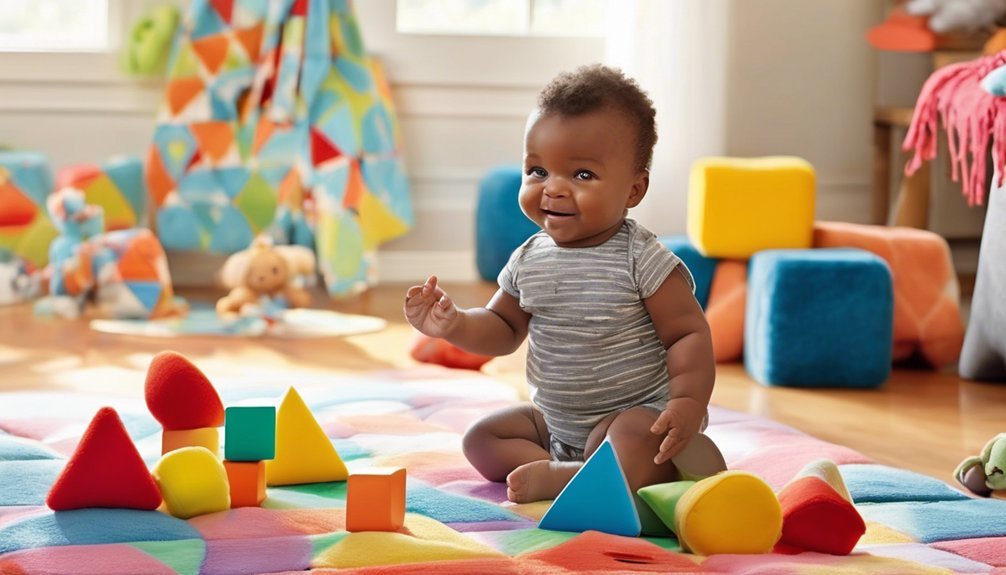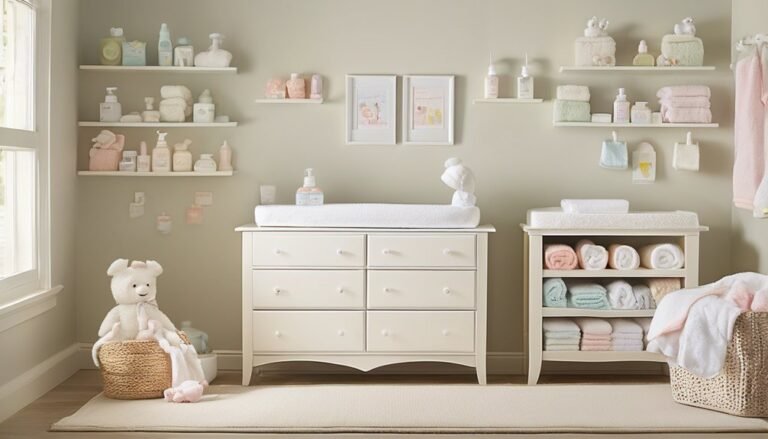Simple Math Concepts for Babies
Did you know that introducing simple math concepts to babies can boost their future academic success? It’s true—early exposure to math through playful activities lays a strong foundation. By engaging in activities like counting toys or sorting shapes, you can spark their curiosity and foster critical thinking. But how can you seamlessly incorporate these fun experiences into everyday life? Let’s explore some effective ways to make math a natural part of your little one’s world.
Key Takeaways
- Introduce counting through everyday objects like toys or snacks to make learning interactive and engaging.
- Use shape sorting toys to help babies recognize and match different shapes while developing motor skills.
- Incorporate simple games, such as scavenger hunts, to encourage problem-solving and critical thinking in a fun manner.
- Integrate musical activities, like singing counting songs, to reinforce number sequences and rhythm.
- Create a math-friendly environment with engaging toys and sensory experiences to stimulate curiosity and support cognitive development.
The Importance of Early Math Exposure

When you introduce your baby to math concepts early on, you’re laying the groundwork for their future learning. The math benefits extend beyond just numbers; they nurture critical thinking and problem-solving skills.
As you engage your little one, you’re fostering their curiosity and encouraging early development in a fun way. Simple activities like sorting toys or recognizing patterns can spark joy and excitement for learning. These moments build confidence, helping your baby feel secure in their abilities.
Plus, the early exposure to math concepts creates a strong foundation for later academic success. Remember, it’s not about pressure; it’s about making learning a delightful experience that strengthens your bond.
Embrace these precious moments—they’re shaping your child’s future!
Counting With Everyday Objects
Everyday objects can turn into delightful counting tools for your baby. You can start by using their favorite toys. Gather a few stuffed animals or blocks and encourage them to count each one aloud. Make it a fun game!
Snack time is another perfect opportunity for counting snacks. Whether it’s crackers, apple slices, or cereal, let your little one count each piece before enjoying them.
You might say, “Let’s count how many grapes we have!” This simple act not only helps with counting but also creates a special bonding moment.
Introducing Shapes Through Play
Shapes are all around us, and introducing them to your baby through play can be a fun adventure! One great way to start is with shape sorting toys. These colorful blocks encourage your little one to match shapes, fostering both cognitive and motor skills. As you play together, talk about each shape—circle, square, triangle—and its unique features.
You can also incorporate sensory exploration by using everyday objects. Gather items like lids, cushions, or even fruits, and let your baby feel their different shapes. This hands-on experience reinforces learning while allowing your baby to engage with their environment.
Exploring Patterns in Nature

Exploring the world around your baby can lead to discovering fascinating patterns in nature. During outdoor adventures, you’ll notice nature patterns in the leaves, flowers, and even the clouds.
Encourage your little one’s observations by pointing out the colors and textures of plants, sparking their color recognition and texture exploration. Watch as they marvel at plant growth, noticing how some bloom while others change with the seasons.
Observe animal movements together—like the rhythmic hopping of a rabbit or the repetitive flapping of a bird’s wings. You can even listen for sound patterns, like the rustle of leaves or the chirping of crickets.
These experiences not only teach math concepts but also deepen your bond with your baby.
Engaging With Music and Rhythm
As you introduce your baby to the enchanting world of music and rhythm, you’ll find that it’s a wonderful way to foster early math skills. Singing songs with simple lyrics encourages musical counting, helping your little one grasp the concept of numbers in a fun, interactive way.
Try clapping your hands or tapping your feet to create rhythmic patterns, inviting your baby to join in. These engaging activities not only stimulate their auditory senses but also lay the groundwork for understanding sequences and patterns.
As you sway to the beat together, you’re building a strong foundation for future learning. Embrace these joyful moments; they’re not just about music, but also about nurturing your baby’s mathematical intuition through rhythm!
Interactive Counting Games
Counting games can be a delightful way to introduce your baby to numbers and basic math concepts. You can start with finger counting, helping your little one connect each number with their tiny fingers. As you count together, use playful expressions to keep them engaged.
Incorporating number songs can make this experience even more enjoyable. Sing catchy tunes that emphasize counting, like “Five Little Monkeys,” encouraging your baby to clap and dance along. You’ll create a joyful atmosphere while reinforcing the idea of numbers.
As your baby giggles and participates, they’re not just having fun; they’re laying the foundation for future math skills. Remember, the key is to keep it lighthearted and interactive!
Storytime With Numbers and Shapes

While you read to your baby, incorporating numbers and shapes can turn storytime into an engaging learning experience. You can create delightful number stories and exciting shape adventures that captivate their imagination.
Here are three simple ways to do this:
- Count Objects: As you read, point out and count objects in the pictures together.
- Identify Shapes: Describe the shapes you see, like circles and squares, and ask your baby to point them out.
- Make Up Stories: Create fun little tales about numbers and shapes, like a triangle going on a journey to find friends.
These activities not only foster early math skills but also strengthen your bond during these magical moments. Enjoy the learning together!
Using Visual Aids for Learning
Visual aids can make learning fun and interactive for your baby. By using colorful charts, you can introduce numbers and shapes in a way that captures their attention. Hang these charts in their play area, so they’re always surrounded by visual stimulation.
Playful blocks are another great tool; stacking them teaches counting and enhances motor skills. As you build towers together, encourage your little one to count each block out loud. This hands-on approach makes learning feel like a game.
Don’t forget to engage with your baby by pointing out different colors and patterns. The more you incorporate these visual aids into playtime, the more excited your baby will be about learning!
Incorporating Math Into Daily Routines
As you go about your daily routines, you can easily weave math concepts into everyday activities with your baby. Here are a few fun ways to get started:
- Bath time bubbles: Count the bubbles as you create them, encouraging your little one to join in.
- Grocery store counting: Count items as you place them in your cart. “One apple, two apples…” makes shopping a playful learning experience.
- Snack time sorting: Organize snacks by shape or color. You can ask, “How many red ones do we have?”
Incorporating these simple activities not only builds early math skills but also creates precious bonding moments.
Enjoy making math a natural part of your daily life together!
Fun Activities to Develop Spatial Awareness

To help your baby develop spatial awareness, you can engage in fun activities that make learning about space and movement enjoyable.
Start with tactile exploration by letting your little one play with different shapes and textures. Use building blocks or soft toys to encourage them to stack, knock down, and rearrange. These movement activities not only stimulate their senses but also help them understand how objects relate to each other in space.
Create obstacle courses using pillows and blankets, guiding your baby to crawl over, under, and through. This playful experience helps them grasp spatial relationships while having a blast.
Encouraging Problem-Solving Skills
While you play with your baby, you can easily encourage problem-solving skills by introducing simple challenges that spark their curiosity. Here are a few engaging ideas:
- Problem-solving puzzles: Use chunky, colorful blocks or shape sorters. Let your little one experiment with fitting pieces together, guiding them when needed.
- Critical thinking activities: Create a mini scavenger hunt. Hide toys around the room and give your baby clues, helping them learn to think critically about where to look.
- Interactive games: Play peek-a-boo or hide-and-seek with objects. This encourages them to think about where things might be and how to find them.
These activities not only nurture problem-solving skills but also deepen your bond, making learning fun and memorable!
Creating a Math-Friendly Environment
Creating a math-friendly environment at home can seamlessly build on the problem-solving skills you’ve started to nurture. Surround your little one with math-friendly toys and engaging sensory experiences that spark curiosity. Simple activities like sorting objects or counting blocks can be both fun and educational.
Here’s a helpful table to guide your choices:
| Math-Friendly Toys | Sensory Experiences |
|---|---|
| Counting Bears | Sand Play |
| Shape Sorters | Water Beads |
| Number Puzzles | Textured Fabrics |
| Building Blocks | Sensory Bins |
Make learning enjoyable by incorporating these elements into daily routines. By doing so, you’ll foster a love for math and create lasting memories together.
Frequently Asked Questions
What Age Should I Start Introducing Math Concepts to My Baby?
You can start introducing math concepts to your baby around 6 months. At this age, early learning and baby milestones focus on shapes, counting, and patterns. Engaging activities will spark their curiosity and lay a strong foundation.
How Can I Make Math Fun for My Baby?
You might think math’s all about numbers and rules, but it’s really about colorful counting and playful patterns! Sing songs, use toys, and create games. Your baby will love discovering math through fun, engaging activities together.
Are There Specific Toys That Promote Early Math Skills?
Absolutely! You’ll find counting blocks and shape sorters are perfect for sparking your little one’s interest. They’ll enjoy stacking, sorting, and counting, all while developing those essential early math skills in a playful way.
How Do I Know if My Baby Is Understanding Math Concepts?
Noticing your baby’s signals can reveal their math recognition skills. If they point at shapes or show excitement with counting games, it’s a sign they’re grasping basic concepts. Keep engaging, and watch their understanding grow!
Can Math Exposure Improve My Baby’s Overall Cognitive Development?
Absolutely! Exposure to math games can boost your baby’s cognitive benefits. Engaging them in playful activities helps develop problem-solving skills and critical thinking, laying a strong foundation for their future learning and growth.
Conclusion
By introducing simple math concepts to your baby, you’re setting them up for a lifetime of learning and curiosity. For instance, consider a toddler who learns to count their toy cars during playtime. This not only makes counting fun but also boosts their confidence in numbers. Remember, incorporating math into everyday activities can spark a love for learning. So, get creative, play, and watch your little one thrive in their mathematical journey!







